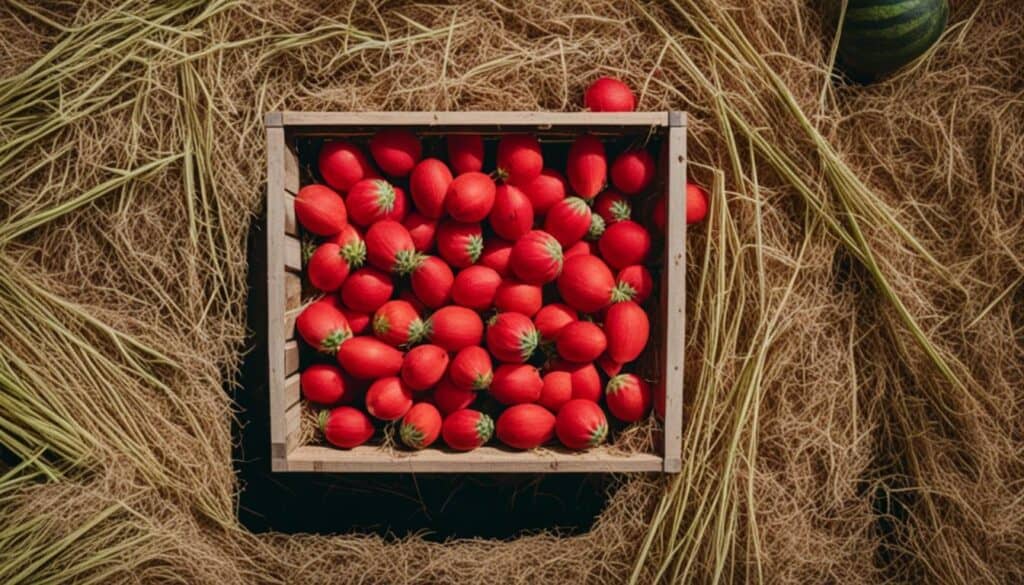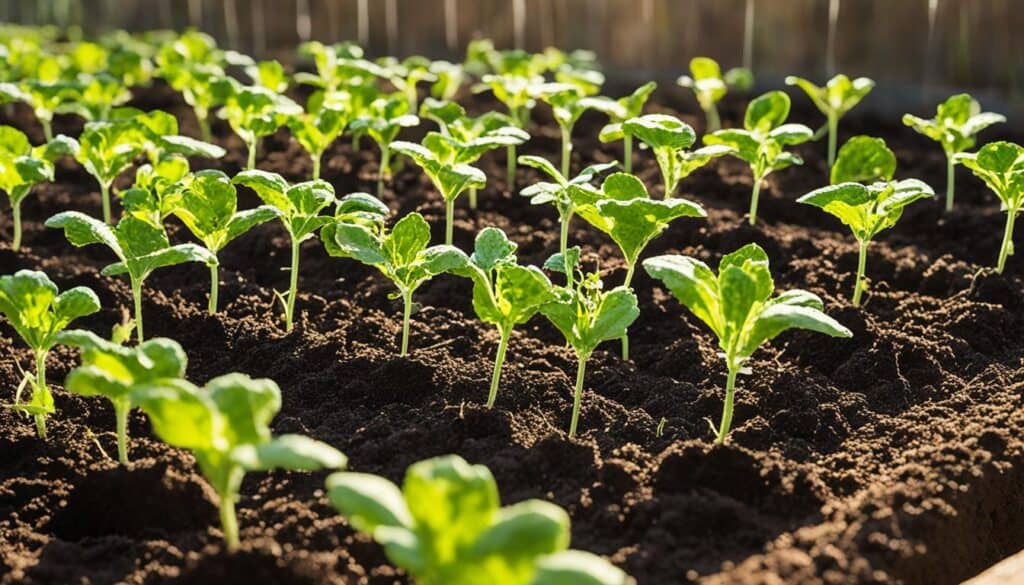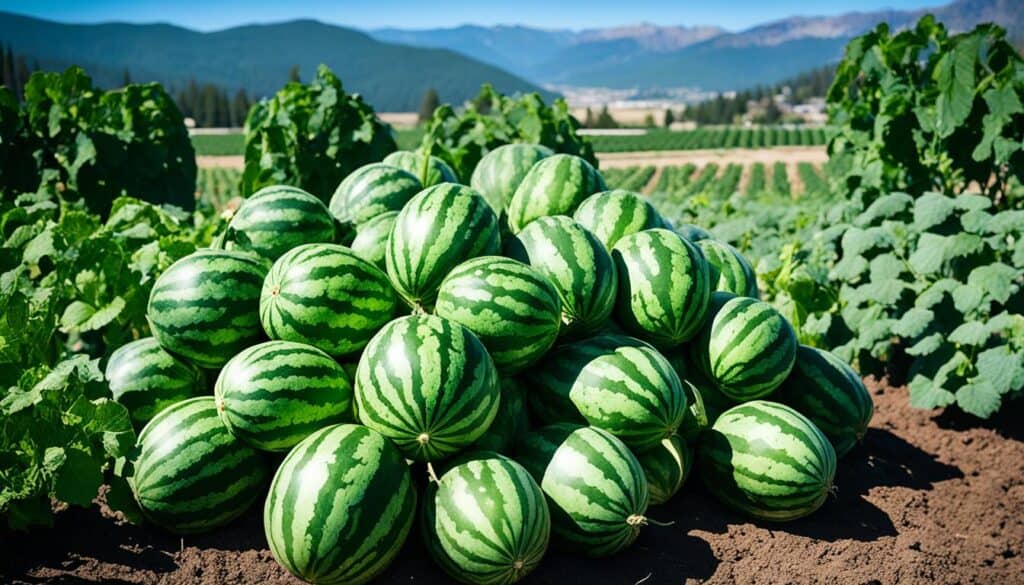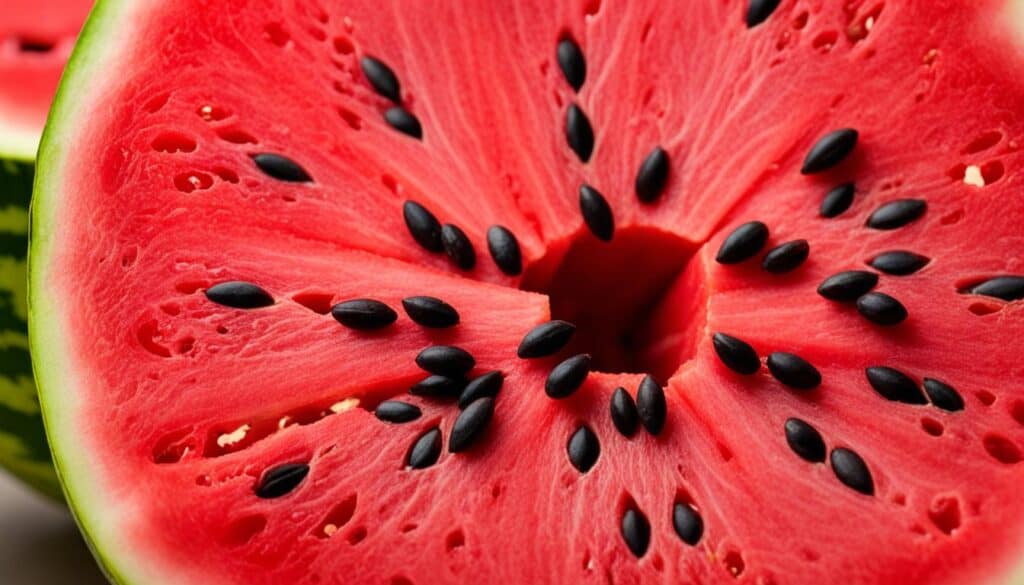Did you know that the average watermelon contains about 20% more lycopene per cup than raw tomatoes? Lycopene is a powerful antioxidant that gives fruits their vibrant red color and offers numerous health benefits. When it comes to the juiciest and most delicious watermelon variety, look no further than the Crimson Sweet Watermelon. This refreshing summer fruit is not only a perfect treat for hot days but is also packed with nutrients and bursting with flavor.
Key Takeaways:
- Crimson Sweet Watermelon is a delicious and refreshing summer fruit.
- Watermelons contain higher levels of lycopene than tomatoes, making them a nutritious choice.
- Enjoy the juiciness and vibrant flavor of Crimson Sweet Watermelon during picnics and outdoor gatherings.
- Crimson Sweet Watermelon is a good source of vitamins and antioxidants that are beneficial for overall health.
- Indulge in the lush taste of summer by growing and enjoying your own Crimson Sweet Watermelons.
Varieties of Watermelon
Watermelons come in various varieties, each with its own unique characteristics. When it comes to selecting the perfect watermelon, you have an array of options to choose from. Here are some popular sweet watermelon types:
- Crimson Sweet: This variety is known for its vibrant red flesh and sweet flavor. Its large size makes it perfect for sharing at picnics and gatherings. [Keyword: watermelon varieties]
- Sugar Baby: If you prefer smaller, more compact watermelons, the Sugar Baby is an excellent choice. Despite its size, it packs a punch in terms of sweetness. [Keyword: sweet watermelon types]
- Charleston Gray: With its pale green rind and super-sweet flesh, the Charleston Gray watermelon is a popular choice among watermelon enthusiasts. Its firm texture and refreshing taste make it a summer favorite. [Keyword: watermelon varieties]
These varieties differ not only in size but also in flavor and texture, providing a range of options to suit different taste preferences. Whether you’re looking for a large, juicy watermelon or a smaller, sweeter variety, you’re sure to find a watermelon that delights your taste buds. [Keyword: sweet watermelon types]
“I love the variety of watermelons available. Each type offers a unique taste experience, from the classic sweetness of the Crimson Sweet to the compact sweetness of the Sugar Baby. There’s something for everyone!”
Growing Crimson Sweet Watermelon
Growing Crimson Sweet Watermelons requires proper care and attention. By following these tips, you can enjoy a bountiful harvest of delicious and refreshing watermelons.
1. Planting Timing and Soil Preparation
Plant the seeds in well-draining soil during late spring or early summer, once the threat of frost has passed. Prepare the soil by loosening it with a garden fork or tiller to a depth of at least 12 inches. This will help the roots to penetrate deeply and ensure optimal growth.
2. Sowing and Sun Exposure
Sow the watermelon seeds about half an inch deep in the prepared soil. Provide them with full sun exposure, as watermelons require plenty of sunlight for growth and sweetness. Ensure that the planting area receives at least 6-8 hours of direct sunlight each day.
3. Regular Watering for Optimal Growth
Water the plants regularly, especially during hot summer conditions, to ensure proper growth and sweetness. Watermelons have high water requirements and need consistent moisture in the soil. Aim to keep the soil evenly moist but not waterlogged to avoid root rot.
4. Harvesting Ripe Watermelons
Harvest the ripe watermelons after 80-90 days by cutting the stem near the base of the fruit. The color of the underside of the watermelon where it touches the ground will turn yellow or cream when the fruit is ripe. Additionally, tapping the watermelon should produce a hollow sound.
By following these tips, you can cultivate your own Crimson Sweet Watermelons and enjoy the juicy, sweet taste of summer.
Benefits of Crimson Sweet Watermelon
When it comes to the perfect summer fruit, the Crimson Sweet Watermelon is a top contender. Its juicy crimson flesh and refreshing flavor make it an ideal choice for picnics and outdoor activities. But the benefits of this delicious fruit go beyond just its taste.
Crimson Sweet Watermelons are not only hydrating but also packed with essential vitamins and antioxidants. They are a good source of vitamins A and C, which are important for maintaining healthy skin and a strong immune system. The antioxidants present in watermelons help to fight against free radicals and promote overall health.
Incorporating juicy crimson sweet watermelon into your diet can help keep you hydrated and refreshed during the hot summer season. Its high water content makes it a perfect thirst quencher, while its natural sweetness satisfies your cravings for something delicious.
“I love indulging in a juicy crimson sweet watermelon on a hot summer day. It’s the perfect way to cool down and enjoy the flavors of the season.” – [YOUR NAME]
So, grab a slice of this refreshing summer fruit and savor its juicy goodness. Whether you’re enjoying it at a picnic or as a healthy snack, the Crimson Sweet Watermelon is guaranteed to be a hit.
| Benefits of Crimson Sweet Watermelon |
|---|
| Hydrating |
| Packed with vitamins A and C |
| Contains antioxidants |
| Refreshing summer fruit |
| Perfect for picnics |
Planting and Growing Requirements
When it comes to growing Crimson Sweet Watermelons, providing the ideal soil conditions and maintaining the right temperature range is crucial for a successful harvest. Let’s take a closer look at the planting and growing requirements that will ensure the sweetest and most flavorful watermelon fruits.
Soil Conditions
Crimson Sweet Watermelons thrive in loamy, rich soil that is well-draining. The soil should be loose and friable, allowing for proper root development and moisture retention. Ensure that the soil has a pH level between 6.0 and 7.5, which is slightly acidic to neutral, for optimal growth. Adding organic matter, such as compost or well-rotted manure, to the soil before planting will provide essential nutrients and improve soil structure.
Temperature Range
Crimson Sweet Watermelons prefer warm temperatures for optimal growth and fruit development. They thrive in a temperature range of 70-95°F (21-35°C). Planting watermelons when the soil temperature reaches at least 70°F (21°C) will promote faster germination and vigorous plant growth. Adequate warmth and sunlight are essential for the watermelon fruits to reach their full sweetness and flavor potential.
| Planting and Growing Requirements | Ideal Conditions |
|---|---|
| Soil Type | Loamy, rich, well-draining soil |
| Soil pH | 6.0-7.5 (slightly acidic to neutral) |
| Temperature Range | 70-95°F (21-35°C) |
| Sun Exposure | Full sun (at least 6-8 hours of direct sunlight per day) |
Providing full sun exposure is essential for sweet and flavorful watermelon fruits. Make sure the plants receive at least 6-8 hours of direct sunlight per day. Additionally, regular watering and mulching around the plants to retain moisture will help maintain consistent growth and prevent stress during hot summer conditions.
Now that we understand the planting and growing requirements of Crimson Sweet Watermelons, we can move on to the exciting process of harvesting and storing these delectable fruits.
Harvesting and Storing Crimson Sweet Watermelon
After patiently waiting 80-90 days, it’s finally time to harvest your delicious Crimson Sweet Watermelons. The firmness of the fruit and the sound it makes when tapped can indicate its readiness for picking. A hollow sound is a good sign that the watermelon is ripe and ready to be enjoyed.
Once you’ve harvested your watermelons, it’s important to store them properly to maintain their freshness and flavor. You can choose to store them in a cool, dry place or refrigerate them. Either way, make sure to keep them away from direct sunlight and other fruits that produce ethylene gas, as this can accelerate ripening and spoilage.
When storing the watermelons in the refrigerator, it’s best to wrap them in plastic wrap or place them in a sealed container to prevent moisture loss and preserve their juiciness. Properly stored watermelons can last for up to two weeks in the refrigerator.
Remember to enjoy your Crimson Sweet Watermelons within a reasonable time frame to savor their optimal flavor and texture. Whether enjoyed as a refreshing snack or incorporated into delicious recipes, these sweet and juicy watermelons are sure to bring summer joy to your taste buds.
Take a look at the image above to visualize the proper storage of your harvested Crimson Sweet Watermelons.
Open-Pollinated and Heirloom Seeds
When it comes to growing the tastiest Crimson Sweet Watermelons, using open-pollinated and heirloom seeds is key. These seeds have a rich history and offer unique qualities that enhance the authenticity and quality of the watermelons you can grow.
Open-pollinated seeds are traditional seeds that have been naturally pollinated by wind or insects. This natural pollination process allows for genetic diversity, resulting in watermelon plants that are resilient and adapted to their environment. By using open-pollinated seeds, you are not only preserving traditional varieties but also supporting the long-term sustainability of our food system.
Heirloom seeds, on the other hand, are old reliable varieties that have been passed down through generations. These seeds carry not only the genetic traits that make Crimson Sweet Watermelons so delicious, but also a rich history and story. By growing heirloom varieties, you are connecting to the past and supporting the preservation of our agricultural heritage.
With open-pollinated and heirloom seeds, you can relish the flavors of watermelons just like our ancestors did. These seeds are a testament to the natural diversity and unique qualities that make Crimson Sweet Watermelons so sought after. So get ready to embark on a journey through time with these extraordinary seeds.
Seed Storage and Germination
H2: Seed Storage and Germination
Proper storage of watermelon seeds is essential to maintain their viability for future plantings. To ensure longevity, store watermelon seeds in a cool and dry place, such as an airtight container or a sealed plastic bag. This will protect them from moisture and potential damage.
When stored under optimal conditions, watermelon seeds can remain viable for 3-10 years. However, for the best germination rates, it is recommended to use the seeds within a year or two of purchase. Fresh seeds generally have higher germination rates and better chances of successful plant growth.
The germination process for watermelon seeds typically takes between 3-9 days. However, the duration can vary depending on several factors, including the environmental conditions and the quality of the seeds. Following the instructions on the seed packet is crucial, as different varieties may have specific requirements for germination.
Creating the ideal conditions for germination is key to successful seedling emergence. Watermelon seeds require a warm soil temperature (around 75-80°F or 24-27°C) to germinate effectively. Maintaining a consistently moist but not overly wet soil during the germination phase is important for optimal results.
In the words of experienced watermelon growers, “With patience, proper storage, and the right growing conditions, you can enjoy a bountiful harvest of juicy watermelons from the seeds you store and germinate.”
USDA Hardiness Zones
When it comes to growing Crimson Sweet Watermelons, understanding the USDA Hardiness Zones is essential. These zones help identify the suitable regions for watermelon growth based on climate conditions. Crimson Sweet Watermelons can thrive in USDA Hardiness Zones 3-9, encompassing a wide range of climates across the United States. However, it’s important to note that individual watermelon varieties may have specific temperature requirements for optimal germination and growth.
In order to ensure the success of your watermelon plants, it is recommended to consult the seed packet instructions for specific temperature guidelines. By considering the recommended temperature range and local frost dates, you can effectively plan your garden and provide the ideal conditions for your watermelon plants to flourish.
In the table below, you can find a general overview of the USDA Hardiness Zones and their corresponding temperature ranges:
| USDA Hardiness Zone | Temperature Range (°F) |
|---|---|
| Zone 3 | -40 to -30 |
| Zone 4 | -30 to -20 |
| Zone 5 | -20 to -10 |
| Zone 6 | -10 to 0 |
| Zone 7 | 0 to 10 |
| Zone 8 | 10 to 20 |
| Zone 9 | 20 to 30 |
By considering the USDA Hardiness Zones and the temperature requirements of your selected watermelon variety, you can ensure that your watermelon plants have the best chance of germination and growth. Remember to provide proper care and attention, such as suitable soil conditions and adequate sunlight, to help your Crimson Sweet Watermelons thrive and produce delicious, juicy fruits.
Organic and Non-GMO Seeds
When it comes to growing Crimson Sweet Watermelons, using organic and non-GMO seeds is not only a choice for quality, but also a commitment to sustainability. Organic watermelon seeds are cultivated without the use of synthetic chemicals, ensuring that your crop remains free from harmful residues.
Non-GMO watermelon seeds are specifically selected to preserve the natural genetic makeup of the plant, without any modifications. This means that the seeds used to grow Crimson Sweet Watermelons are in their purest form, delivering the authentic flavors and traits that watermelon enthusiasts adore.
By opting for organic and non-GMO watermelon seeds, you not only prioritize the health and vitality of your watermelon crop, but also support environmentally friendly farming practices. These seeds contribute to the preservation of biodiversity, as well as healthier ecosystems for future generations.
| Benefits of Organic and Non-GMO Seeds |
|---|
| 1. Purity: Organic and non-GMO seeds are free from synthetic chemicals and modifications, resulting in a cleaner and more natural crop. |
| 2. Sustainability: By choosing organic and non-GMO seeds, you support sustainable farming practices that promote environmental health and biodiversity. |
| 3. Authenticity: These seeds preserve the authentic flavor and traits of the Crimson Sweet Watermelon, ensuring the deliciousness you expect. |
| 4. Health Benefits: Organic watermelon seeds provide a nutrient-rich source of essential vitamins, minerals, and antioxidants. |
When it comes to growing Crimson Sweet Watermelons, it’s important to sow the seeds of authenticity and sustainability. By selecting organic and non-GMO watermelon seeds, you not only embark on a journey of taste and flavor, but also contribute to a greener and healthier future.
Conclusion
In conclusion, indulging in the juicy, refreshing taste of Crimson Sweet Watermelons is a delightful way to enjoy the flavors of summer. By following proper growing practices, selecting the right seeds, and providing optimal conditions, you can experience the joy of cultivating your own delicious watermelons. Whether enjoyed at picnics or as a refreshing summer snack, Crimson Sweet Watermelons are sure to satisfy your cravings and add a burst of sweetness to your summer festivities.










Leave a Reply